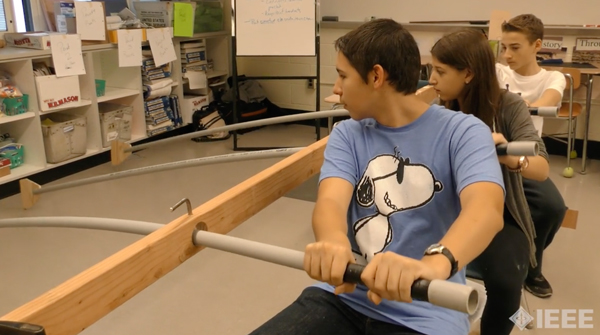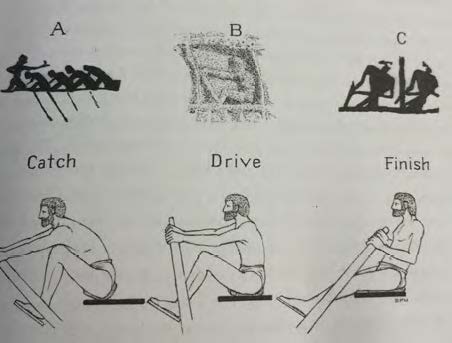 Photo taken from Ms. Bisconti’s 8th grade class, on Triremes – Democracy and Empire, 2016. Ms. Bisconti is a Social Studies Teacher, at Heritage Middle School, Livingston NJ (Note: An option prior to classroom activity is to have students watch one of the videos below, either in class or have them watch at home as a flipped classroom – Please note, these are not IEEE videos.)
Photo taken from Ms. Bisconti’s 8th grade class, on Triremes – Democracy and Empire, 2016. Ms. Bisconti is a Social Studies Teacher, at Heritage Middle School, Livingston NJ (Note: An option prior to classroom activity is to have students watch one of the videos below, either in class or have them watch at home as a flipped classroom – Please note, these are not IEEE videos.)
Video 1: SeaTrials of the Trireme Olympias
This video is 14:17 in length, and was posted on YouTube by the Bath Royal Literary and Scientific Institution (brlsi.org). BRLSI organization is an educational charity organization in Bath, UK.
Description of video: The Olympias is a full-size replica of an ancient Greek Trireme warship, co-designed by John Coates, naval architect and historian and one of the founders of the modern BRLSI. This video shows Olympias undergoing sea trials in 1990. It was shot by Christopher Miles, and features a commentary written by John Coates and read by his son Julian. Edited for BRLSI by Paul Stephens. This video was shown on 11th October 2011, at a BRLSI lecture on Greek Triremes by Professor Boris Rankov (who appears in the video). Visit www.brlsi.org (choose ‘Poster Gallery’) for more details.
Video 2: Trireme Edit for Class
7:35 minutes long, and appears to be an edited cut of the SeaTrials of the Trireme Olympias found above and was found on YouTube. Per the YouTube account, the owner and creator of this edited video is Sean Nowland, a middle school teacher based in Oregon.
Materials Needed for Full Simulation
- 4 chairs
- A wood plank/board that’s length is long enough to stretch along 4 chairs and its height should be long enough to accommodate four ,3-inch, diameter holes (See above plank.)
- A support structure to hold the wood plank/board in place, at an elevation relative to the height of your chairs, will need to be secured to both ends of the wood plank/board. (This could be a sawhorse. Wood/plank needs to be secured tightly to the sawhorse.)
- 4 long pieces of flexible PVC piping (needed to simulate the oar)
- 4 pieces of plywood or cardboard, cutout in the shape of an end of an oar, to be secured on the PVC piping as shown above.
Consult with someone in your maintenance/tech/shop/art/engineering department to assist with making the above simulator.
Instructions
- Place the 4 flexible PVC pipes in the 4 holes in the plywood, and attached oar ends.
- Have students review the Oarsman Simulation Activity sheet (attached) and view the Trireme Olympias video (2:38)
- Instruct 4 students to each sit in a chair, have one student take the role of the coxswain, a steersman of a racing shell who usually directs the rowers, have them call out “Catch!, Drive!, Finish!, Release!”
- Each student must coordinate with each other to ensure all row at the same time, to ensure that the oars aren’t banging against each other and are moving at the same rate.
- Remind your students of the extreme conditions the oarsmen faced during the times of the Greek Triremes while out at sea. Ask them if it was difficult for the 4 of them to coordinate and row at the same time, then ask them to imagine how difficult it would have been to coordinate the hundreds of oarsmen in the Triremes.
Option: If creation of simulation mechanism isn’t possible: Be creative with chairs! Extreme caution is required for this option! You can create a simple simulation by having 3-4 students line up in a row, seated on wheeled chairs, one behind the other. The teacher or TA would also sit in a wheeled chair facing the row of students. Teacher would call out “Catch!, Drive!, Finish!, Release!” to keep the students in time. (See videos below for ideas. Please note, these videos do not belong to IEEE, nor has IEEE had any role in creating these videos. They were made available by third parties on YouTube, and are merely indicated here to provide you with ideas. IEEE is not responsible for their content) Have fun!
Video: Classroom Rowing
https://www.youtube.com/watch?v=Yn8Lr6t-_NE
Video: office rowing team
https://www.youtube.com/watch?v=O9eqnc6EM_o
Classroom Activity – Oarsman Simulation
 John R. Hale, in his book, Lords of the Sea said, “the beat of the oars was the heartbeat of Athens in the city’s Golden Age”. As you have discovered, the power of the Trireme lies with the men who row. Rowing required tremendous strength, skill and stamina. Now you and your teammates will step back in time, take a seat at the simulator and suspend reality. Grab the oars and pretend you are rowing for the glory and power of Athens! Behold the power of the Athenian oarsman!
John R. Hale, in his book, Lords of the Sea said, “the beat of the oars was the heartbeat of Athens in the city’s Golden Age”. As you have discovered, the power of the Trireme lies with the men who row. Rowing required tremendous strength, skill and stamina. Now you and your teammates will step back in time, take a seat at the simulator and suspend reality. Grab the oars and pretend you are rowing for the glory and power of Athens! Behold the power of the Athenian oarsman!
First your rowing lesson:
Please take a look at the image. Notice the form and positioning of the oars. Here are some key terms so that you understand the motion:
- Catch – The beginning of the rowing stroke where the oar blade is set in the water.
- Drive – The part of the stroke where the blade is pulled through the water.
- Finish – The final part of the stroke where the blade comes out of the water.
- Release – Pushing down on the handle to raise the blade out of the water at the end of the stroke to begin the recovery.
- Recovery – The part of the stroke where the rower comes slowly up the slide to return to the catch.
Watch the Olympias video
Please watch from the beginning to about 1:20 minutes. This video documents the construction and sailing of the Olympias, a full-scale working replica of the legendary 170-oared Athenian trireme of the 5th century B.C. The ship is the fastest human-powered vessel on the planet. While you watch, pay attention to the movements
Now it’s your turn!
- Sit down all facing the same direction.
- Take an oar and bring it across your lap.
- Follow the motion of catch, drive, finish, release, recovery and remember you need to be in sync. You may even want to play the rowing segment of the video so you can hear the beat! The Whumff! Whroosh!
Reflection
Now that you have tried it, (without water, chaos of actual battle, and for an entire day) Do you think the oarsman deserve their honored status? Why?
When engaging in the IEEE REACH hands-on activities contemplated in the IEEE REACH lesson plans please proceed with caution and use all reasonable safety measures. All IEEE REACH hands-on activities are designed for classroom use only, with supervision by a teacher or an adult educator. Please be advised that IEEE shall not be responsible for any injuries or damages related to the use of these lesson plans or any activities described herein.
